Leopalace is one of the largest flat/apartment rental companies in Japan. If you want a real self-contained home (rather than a room with shared facilities in a guest house) they are a good option to consider as they are happy to rent to foreigners, and have information and telephone help available in English. Usually the flats come pre-furnished (chairs, table, TV, fridge/freezer, microwave) so you can move in without having to buy too much.
I’ve lived in three Leopalace flats, two in Takamatsu and one in Tokyo and have had very few problems. Sometimes you can hear your neighbours, but fortunately most people in Japan are quite considerate about noise. When appliances or facilities have broken (e.g. air conditioning or hot water) Leopalace arranged for someone to come round and fix them for free.
They do have an English language website, which you should read to familiarise yourself with their different types of contracts and flats. Unfortunately there is no flat search facility on the English language website so if you want to find the best flats you need to learn how to use their Japanese language site. Much of this post will be tips for using the Japanese language site.
Leopalace contracts
There are three main types of contract at Leopalace.
- Chintai – long term contract where you pay month by month. For many flats this means two years with an option to cancel the contract with no penalty after six months.
- Monthly contract – you can sign from 30 days to 24 months and you pay in advance.
There are two types of monthly contract, the monthly plan (minimum 90 days) and the short term plan (minimum 30 days).
Leopalace costs
Leopalace’s prices are more simple and transparent than a lot of other Japanese rental companies, but that doesn’t mean they are simple to understand.
When renting with many private landlords you have to pay charges like key money (could be 2 month rent), and a deposit (which could be another few months rent). You don’t need to pay either of these for small Leopalace flats, but for larger ones you may need to pay a deposit.
I’ve rented on both the short term and the chintai contract so I can give you some examples of the costs.
Short term plan (30 day contract)
This was for a very small flat less than 30 minutes (walking and train) from Shibuya.
- ¥115,200 – 30 days rent.
- ¥28,000 – administration fee.
- ¥9,970 – key change fee (this isn’t the same as key money, this is a fee for changing the locks).
- ¥1,600 – Leo-net internet.
With the short term plan there are no utility bills to pay (they are included) or cleaning fees (that is included in the rent too). The total cost for 30 days was therefore ¥154,770 paid in cash before moving in.
Chintai (2 year contract)
This example is for the same flat. If you move from a monthly plan to a chintai contract in the same flat you don’t have to re-pay the key change fee, but I’m including the fee here to give an idea of the maximum total cost. Each months rent is ¥90,000 – cheaper than the ¥115,200 you pay if you rent for just 30 days.
First up, here are the initial moving in charges which need to be paid in advance.
- ¥90,000 – first month’s rent.
- ¥520 – first month’s environmental fee (some fee needed by the council – maybe to cover rubbish collection?).
- ¥90,000 – second month’s rent – you need to pay the first two months rent in advance.
- ¥520 – second month’s environmental fee.
- ¥9,600 – Leonet for first 6 months.
- ¥28,000 – Insurance/life support – This covers fire insurance, and the ‘life support’ service they provide if something breaks. It does not cover earthquake damage.
- ¥72,410 – Guarantee fee – you don’t need guarantors with Leopalace if you are a foreigner, and you don’t need to pay key money or a deposit. You do however need to pay this fee, the purpose of which I’m still not clear about.
There are some optional fees like an ‘anti-bacterial cleaning fee’ which are optional, and in my opinion not worth paying.
That works out at a grand total of ¥285,200 to move in.
Here are the standard monthly fees after the first two months rent are used up.
- ¥90,000 – monthly rent.
- ¥520 – monthly environmental fee.
- ¥500 – bank debit fee (for collecting rent out of your bank account).
And in order to move out there is a cleaning fee.
- ¥29,920 – cleaning fee
This contract is for two years, but it can be ended after one year with no penalty. If it is ended before one year the extra charge is ¥85,500.
You need to be careful to factor in the initial and final costs into your calculation. In the case of this flat if I average all the costs over one year here is the breakdown for each month.
- ¥90,000 – rent
- ¥520 – environmental fee
- ¥2,333 – insurance/life support
- ¥6,034 – guarantee fee
- ¥1,600 – Leonet
- ¥2493 – cleaning fee
- ¥500 – bank debit fee
So the average for each month if you stay a year is about ¥103,480. If you stayed for two years the cost would be lower as the one off costs would be split over two years instead of one.
On top of this you have to pay your utility bills (electricity, gas, water).
Finding a flat with the Leopalace Japanese website
If you’re still reading then let’s have a look at Leopalace’s Japanese website. Even if you can’t read any Japanese you can start to decode it using Google Translate or Google Chrome.
A useful tip is to print out key sections of the site, and as you decode them write on your print outs what the buttons / fields are for what. By doing this you can soon start to find good flats.
Leopalace main page
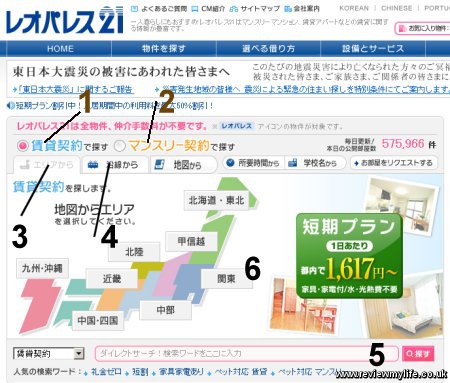
- Search for chintai contract flats.
- Search for monthly contract flats (you usually get the same list of flats for chintai or monthly, these options just affect the price you see).
- Search by area.
- Search by train line.
- Keyword box – most useful for quickly looking up the flats once you have the reference number.
- Map of Japan. The number 6 is over the Kanto region which contains Tokyo.
So for our example select ‘monthly’ (2), choose the train line search tab (4), and press on the Kanto region (6).
Then select the Tokyo area (東京都). You’ll then get a screen with loads of train lines and the number of available properties in brackets.
Search by train line
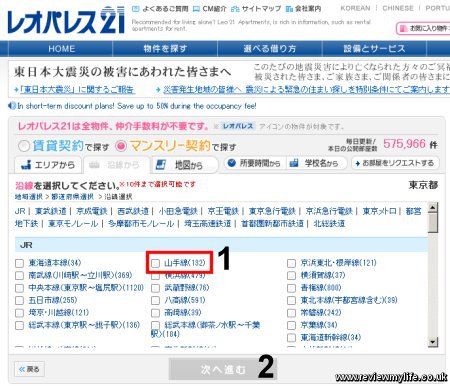
There are two ways to figure out which train line is which. Either see if Google Translate/Chrome turns the train line names into something sensible, or type the name of the train line you want into Wikipedia, and on the Wikipedia page you are sure to find the Japanese version of the name. You can then locate it on the Leopalace site.
Let’s have a look for flats near the Yamanote line (山手線). It is the one in the red box. Then press the ok button (2).
You’ll now get a list of stations that have flats near them. I’ll select Tokyo and Ikebukuro stations (東京駅 & 池袋駅).
Narrowing down the search
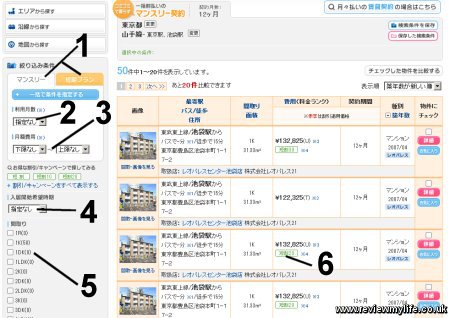
- The left tab is for monthly contracts. The right hand one (in orange) is for short term plan rentals.
- Select how many months you want. The price is cheaper as the contract length increases. For the short term plan there are two pull downs here – one selects the rough number of days, e.g. 30-39, and the one below it selects the exact number of days.
- Minimum and maximum price.
- How soon you want to move in. e.g. in two weeks, in a month, in two months. The earliest date you can move in will be at least 8 days in the future. This is because Leopalace need time to arrange the flat cleaning, utility services, and maintenance.
- Type of flat. L=living room, D=dining room, K=kitchen. Most Leopalace places are 1K. Meaning there is a combined living/sleeping area and a small kitchen area.
- Many flats (particularly if they are not vacant) have discounted prices. The discounts can range from 10% to 50%. You can get some good deals if you aren’t too fussy.
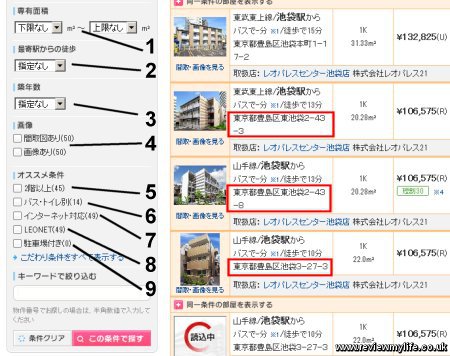
- Floor area.
- Walking distance from nearest train station (note – do check which station it is near to – it is not always the one you picked).
- Building age.
- Floor plans and images.
- 2nd floor or above.
- Separate bathroom / toilet.
- Internet enabled (this could be any type of internet – so I recommend you make sure it has Leonet instead).
- Leonet enabled – the best kind of Leopalace internet, with a Lan socket in the flat. I have another post about setting up Wifi with Leonet.
- Parking.
Don’t be too fussy with any restrictions or you might end up with 0 results. You probably want to tick ‘Leonet’) and then maybe one other. The numbers in brackets tell you how many results you will be left with if you apply the exclusion.
To find out exactly where the flats are paste the Japanese address (I’ve hightlighted some of them in red so you can see where they are) into Google maps. If you use the Japanese address Google Maps usually gives an accurate location. If you use the romanised form of the address it might not even match the address to the correct region of the country.
Leopalace flat details page
If you click on the flat image you’ll go to the individual flat information page. Here are some of the important areas of the page.
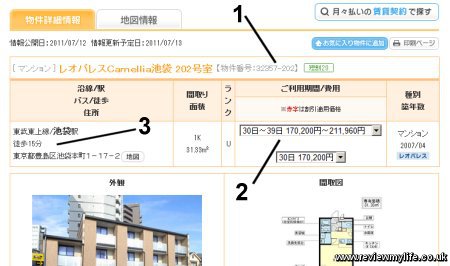
- Building/flat number. If you want to find the same flat again, or rent it, then it is very useful to have the flat number. You can put the number into the search boxes to quickly access it. With this number ‘32357-201’, the first part ‘32357’ is the building number. ‘201’ is the flat number. Using their usual numbering convention you can tell that this flat is on the 2nd floor.
- Prices for the various lengths of contract.
- Walking time in minutes from a station. The address is below so you can check which station they mean.
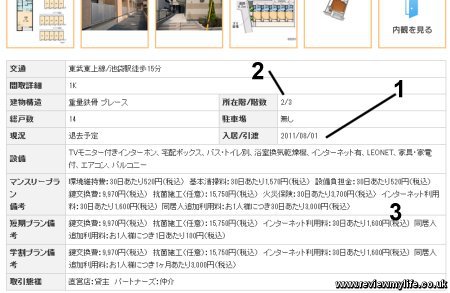
Further down on the same page are:
- The date when the flat is available from. If it is currently vacant and this date is only about 8 days away you’ll find that it will creep forward each day.
- The floor that the flat is on (2) and the number of floors in the building (3).
- Price details of the other charges – insurance, cleaning etc. Google Translate/Chrome do a reasonable job of translating these.
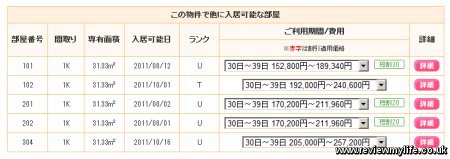
Then near the bottom of the page you’ll see a box listing any other flats in the same building that are also available. This can be very useful if you really like a building, as it will give you more options in case one flat becomes booked. You can also see if any of the flats have good discounts.
Signing the contract
If you visit a Leopalace office to arrange a flat or sign a contract I’d recommend you take a Japanese speaker with you. They do have English speaking staff in some offices like the Shinjuku one, but they might not be able to understand more complicated questions.
Although you don’t need a guarantor, they will want some emergency contact details. They may want one contact from your own country, and two from Japan. So come prepared with three sets of phone numbers, names, and addresses.
You should also allow 2-3 hours to arrange everything and sign the contract. There is a lot of paper work that needs signing, and a lot of details that you have to fill in multiple times on different bits of paper. Here is the image of all the paper work that we were given after signing a chintai contract. In there is a contract, Leonet information, life support document, a Leopalace manual, receipt, and probably more.
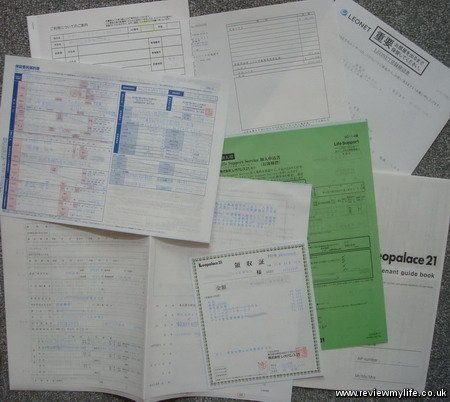
Over to you…
This post is certainly not a comprehensive guide to using the Leopalace website, but with the tips I’ve given you, some time, and maybe with the use of Google Translate/Chrome you may be able to find a good rental flat in Japan.
Thank you so much. I am a student about to rent at Leopalace and I was quite troubled because all the extra expenses.My apartment would be around 81.000yen base rent, so saying that it will be around 100.000yen with gas, water, electricity and such, is a good estimate? I would love to ask some more questions. I have been searching all over the web for this kind of article!!
Hi Bert, I had a look at some recent bills. The gas and water were each about 2000 Yen for July. The gas is only used to heat the water – the cooking hobs are electric.
The most recent electricity bill I can find right now was from February – that was for 7400 Yen. Obviously the February bill will have included a lot of electricity for heating. I can’t find a recent Summer bill – obviously that would include a lot of electricity for air conditioning – but I’m not sure whether we were using more electricity for heating or cooling.
So your estimate sounds pretty good. My bills are for a Leopalace flat with two people.
Thank you for this guide! It’s very detailed and easy to understand.
I will start working in Japan next month and I am considering Leopalace as a suitable place to stay. I have a good candidate for an apartment in Yokohama, but I will be signing the contract once I arrive in Japan. Do you happen to know until what time are Leopalace offices open? I am worried that my arrival time in Narita airport is too late that business hours will be over once I get there.
Hi Charlie – Leopalace have a list of their office areas linked on this page http://www.leopalace21.com/center/index.html.
The Kanto offices are listed at http://www.leopalace21.com/apps/searchCondition/centerListAction.do?tai=3. Click on the blue boxes in the ‘Map’ column to get details of the individual office opening times / days.
I clicked around a few of them and they seem to shut at 6pm/7pm. If you can’t understand the Japanese then Google Translate will turn those pages into something readable. Hope this helps.
Thank you very much for the info!
I checked the location of the office and how long it would take to go there from Narita Airport, it seems I can make it.
Thank you for the info
I will be renting 2 months in fukuoka and 1 month in tokyo, so do I need to pay the registration fee twice ? Thank you for your help
Hi Palvy, I’m not sure about this, but I’d certainly mention at the second Leopalace office that you have already paid a registration fee. Hopefully they won’t make you may it again. Have a good time over there!
Thank you so much for all your infos
Thank you for this guide! It is a lot easier to understand :)
I am going to Japan in under a month and my company strongly recommends me using leopalace. However the two year contract gave me reservations, but I spoke to my friend in Japan whose company also used Leopalace and she has the same Chintai contract described by you; after six months you may dissolve the contract without any fee. However, when I inquired with Leopalace I got an email stating that the Chintai contract can be broken after twelve months with a fine of one months rent! Is it only certain individuals that can get the contract with your terms?
Wow! You are amazing! Your information is so organized and such clear instructions! Thank you so much! : )